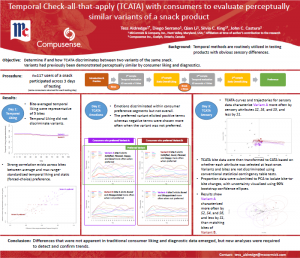Benefits and limitations with using Temporal Check-All-That-Apply (TCATA) with consumers to evaluate perceptually similar variants of a snack product
 The present study was to determine if and how TCATA could discriminate two variants of the same snack (A, B) that had previously been demonstrated perceptually similar by consumer liking and diagnostics. Consumers evaluated five consecutive bites of each variant at McCormick & Co., Inc.: via temporal liking on Day 1, TCATA with 12 emotion attributes on Day 2, and TCATA with 9 sensory attributes on Day 3. 112 consumers attended all 3 evaluation days.
The present study was to determine if and how TCATA could discriminate two variants of the same snack (A, B) that had previously been demonstrated perceptually similar by consumer liking and diagnostics. Consumers evaluated five consecutive bites of each variant at McCormick & Co., Inc.: via temporal liking on Day 1, TCATA with 12 emotion attributes on Day 2, and TCATA with 9 sensory attributes on Day 3. 112 consumers attended all 3 evaluation days.
Temporal Liking: Static (collected after each temporal evaluation) and temporal liking did not discriminate the variants. Consumers clusters were undetectable.
TCATA Emotion: Curves and trajectories visualize temporal changes. Emotions discriminated within consumer preference segments but not overall. Positive emotions (happy, good, pleased, satisfied) tended to be co-elicited with the better liked variant (in that session), with negative emotions (bored, disappointed) co-elicited with the other variant.
TCATA Sensory: Variant A tended to be slightly better liked on Day 3, and TCATA curves and trajectories for sensory data characterize A more often by sensory attributes S2, S4, and S5, and less by S1, relationships that align with TCATA results obtained previously from an employee panel. TCATA bite data were then transformed to CATA based on whether each attribute was selected at least once. Variants and bites are not discriminated using conventional statistical contingency table tests. Proportion data were submitted to PCA to isolate bite-to-bite changes, with uncertainty visualized using 95% bootstrap confidence ellipses. Results show A characterized more often by S2, S4, and S6, and less by S1, than matching bites of B.
Temporal methods are routinely utilized in testing of products with obvious sensory differences. Here, consumers evaluated perceptually similar variants with TCATA. Differences that were not apparent in traditional consumer liking and diagnostic data emerged, but new analyses were required to detect and confirm trends.
![]()
Aldredge, T., Serrano, D., Li, Q., King, S. C., & Castura, J. C. (2017). Benefits and limitations with using Temporal Check-All-That-Apply (TCATA) with consumers to evaluate perceptually similar variants of a snack product. 12th Pangborn Sensory Science Symposium. 20-24 August. Providence, RI, USA.